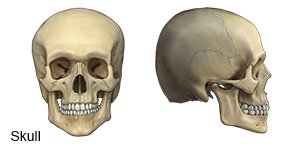Facial Fracture in Children
Medically reviewed by Drugs.com. Last updated on Aug 4, 2025.
What is a facial fracture?
A facial fracture is a break in one or more of the bones in your child's face. A facial fracture may also damage nearby tissue.
 |
What are the signs and symptoms of a facial fracture?
- Pain, swelling, or bruises
- Headache
- Tingling or numbness
- Blurry vision, double vision, or seeing floaters (spots)
- Decreased eye movement or pain when your child moves his or her eyes
- Eyes that are sunken or not in the normal position, or swollen eyelids
How is a facial fracture diagnosed?
Tell your child's healthcare provider about the injury. Your child's eyesight, pupils, and eye movements will be checked. Your child's provider may use a device to look inside your child's eye. He or she will also check for skin wounds. Your child may also need any of the following:
- X-ray or CT scan pictures may show broken bones and damaged tissue and blood vessels. Your child may be given contrast liquid to help the injured area show up better. Tell the provider if your child has ever had an allergic reaction to contrast liquid.
- An ultrasound may be done to check for damage to your child's facial bones and tissue.
How is a facial fracture treated?
A facial fracture may be left to heal on its own if the broken bone stays in its normal position. Your child may need any of the following for a severe fracture:
- Medicine may be given to treat or prevent pain or a bacterial infection.
- Surgery may be needed to return your child's bones to their normal position if the fracture is severe. Pins, plates, and screws may be used to hold broken bones together. Surgery may also be needed to fix damage to the eyes, nose, mouth, nerves, or blood vessels.
Call your local emergency number (911 in the US) if:
- Your child has a seizure.
- Your child has trouble breathing.
When should I seek immediate care?
- Your child becomes confused or more fussy, restless, or sleepy than usual.
- Your child has blood or clear fluid coming from his or her nose or ears.
- Your child has trouble hearing or speaking.
- Your child has blurred or double vision.
- Your child's pupil looks larger in one eye.
When should I call my child's doctor?
- Your child has a fever.
- Your child is vomiting.
- Your child has a headache that is getting worse, even after he or she takes pain medicine.
- You have questions or concerns about your child's condition or care.
Care Agreement
You have the right to help plan your child's care. Learn about your child's health condition and how it may be treated. Discuss treatment options with your child's healthcare providers to decide what care you want for your child. The above information is an educational aid only. It is not intended as medical advice for individual conditions or treatments. Talk to your doctor, nurse or pharmacist before following any medical regimen to see if it is safe and effective for you.© Copyright Merative 2025 Information is for End User's use only and may not be sold, redistributed or otherwise used for commercial purposes.
Learn more about Facial Fracture
Care guides
Further information
Always consult your healthcare provider to ensure the information displayed on this page applies to your personal circumstances.
